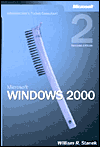
Home ◊ Books ◊ Training Seminars ◊ Registration

Home ◊
Books ◊
Training Seminars
◊ Registration
 Windows
2000 Administrator's Pocket Consultant 2nd Edition
Windows
2000 Administrator's Pocket Consultant 2nd Edition|
The Amazon.com Review
One of the best Windows 2000 references yet published, Microsoft Windows 2000 Administrator's Pocket Consultant is a professional-level how-to guide for all versions of Windows 2000. Designed with the mobile expert in mind, the cover of the book has a tough, plastic-coated surface (like that of a playing card) and rounded corners (though it won't quite lie flat without weights). Its contents are similarly hard-boiled. Concepts are explained in expertly written and carefully organized prose, while succinct procedures tell you how to meet requirements and numerous tables list options and their effects. There aren't many screen shots, but that's okay because this is a reference for people who don't need them. Coverage is wide-ranging and includes everything a power user or system administrator would want to know about the configuration, expansion, and efficient administration of Windows 2000 systems and networks. If you're not sure how to best go about an incremental backup or the installation of a Domain Name Service (DNS) server under Windows 2000, you'll find what you need here. If you know a bit about Windows NT (or even Unix) in a networking context, you can extract all you need to know about Windows 2000's unique operational features. Similarly--even though it wasn't designed for the purpose--this book makes a great study aid for the Microsoft Certified Professional (MCP) tests on Windows 2000. FROM THE PUBLISHER
Here's the eminently practical, pocket-sized reference for IT
professionals administering Windows 2000 Server and Windows 2000
Professional. The second edition of this popular guide has been
fully updated to cover issues and topics related to Service Pack
3-including security, interoperability, and disaster planning
and recovery-as well as core support tasks such as managing file
systems and drives, supporting TCP/IP networking, configuring
network printers, using Group Policy, and administering Active
Directory(r) services. Featuring quick-reference tables, lists,
and step-by-step instructions, this Administrator's Pocket
Consultant is designed to help you solve problems
fast-whether you're at your desk or in the field!
SYNOPSIS
A fast-answers, daily operations guide to Windows 2000 featuring
quick-reference tables, lists, and step-by-step instructions.
The fully updated second edition now covers issues and topics
related to Service Pack 3 and later, including new security
information.
|
Speed and ease of reference is an essential part of this hands-on guide. The book has an expanded table of contents and an extensive index for finding answers to problems quickly. Many other quick reference features have been added as well. These features include quick step-by-step instructions, lists, tables with fast facts, and extensive cross-references. The book is broken down into both parts and chapters. Each part contains an opening paragraph or two about the chapters contained in that part.
Part I, “Microsoft Windows 2000 Administration Fundamentals,” covers the fundamental tasks you need for Windows 2000 administration. Chapter 1 provides an overview of Windows 2000 administration tools, techniques, and concepts. Chapter 2 explores the tasks you’ll need to manage Windows 2000 systems. Chapter 3 covers monitoring processes, services, and events. The final chapter in this part covers automating administrative tasks, policies, and procedures.
In Part II, “Microsoft Windows 2000 Directory Services Administration,” you’ll find the essential tasks for administering user, computer, and group accounts. Chapter 5 introduces Active Directory Service structures and details how to work with Active Directory domains. Chapter 6 explores core Active Directory Service administration. You’ll learn how to manage computer accounts, domain controllers, and organizational units. Chapter 7 explains how to use system accounts, built-in groups, user rights, built-in capabilities, and implicit groups. You’ll find extensive tables that tell you exactly when you should use certain types of accounts, rights, and capabilities. The core administration tasks for creating user and group accounts are covered in Chapter 8, with a logical follow-up for managing existing user and group accounts covered in Chapter 9.
The book continues with Part III, “Microsoft Windows 2000 Data Administration.” Chapter 10 starts by explaining how to add hard drives to a system and how to partition drives. Then the chapter dives into common tasks for managing file systems and drives, such as defragmenting disks, compression, encryption, and more. In Chapter 11, you’ll find tasks for managing volume sets and RAID arrays, as well as detailed advice on repairing damaged arrays. Chapter 12 focuses on managing files and directories and all the tasks that go along with it. You’ll even find tips for customizing folder views with folder templates. Chapter 13 details how to enable file, drive, and directory sharing for remote network and Internet users; it then goes on to cover Active Directory Service object security and auditing. Chapter 14 examines data backup and recovery and includes a section on managing media pools.
Part IV, “Microsoft Windows 2000 Network Administration,” covers advanced administration tasks. Chapter 15 provides the essentials for installing, configuring, and testing Transmission Control Protocol/Internet Protocol (TCP/IP) networking on Windows 2000 systems—covering everything from installing network adapter cards to actually connecting a computer to a Windows 2000 domain. Chapter 16 begins with a troubleshooting guide for common printer problems and then goes on to cover tasks for installing and configuring local printers and network print servers. The final three chapters in this section focus on the key Windows 2000 services: DHCP, WINS, and DNS. DHCP is used to assign dynamic IP addresses to network clients. WINS is used to resolve computer names to IP addresses. DNS is used to resolve host names to IP addresses.
This book is available everywhere Microsoft books are sold. I hope you'll order the book from your favorite bookstore. All on-line bookstores carry the book as well. Here's the direct link to order the book at these bookstores:
Books ◊ Training Seminars/Locations ◊ Training Registration ◊ Self-Study Training
The obligatory copyright statement:
©William R. Stanek 2004-2008. All Rights
Reserved.